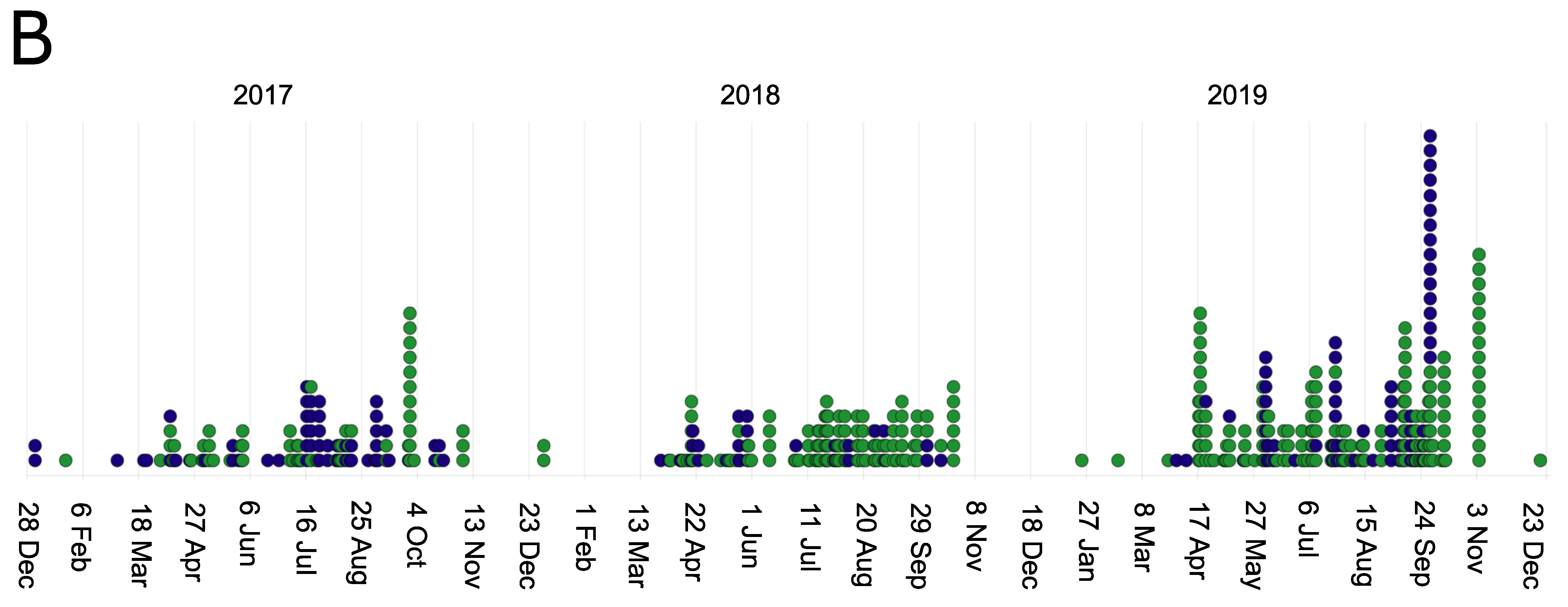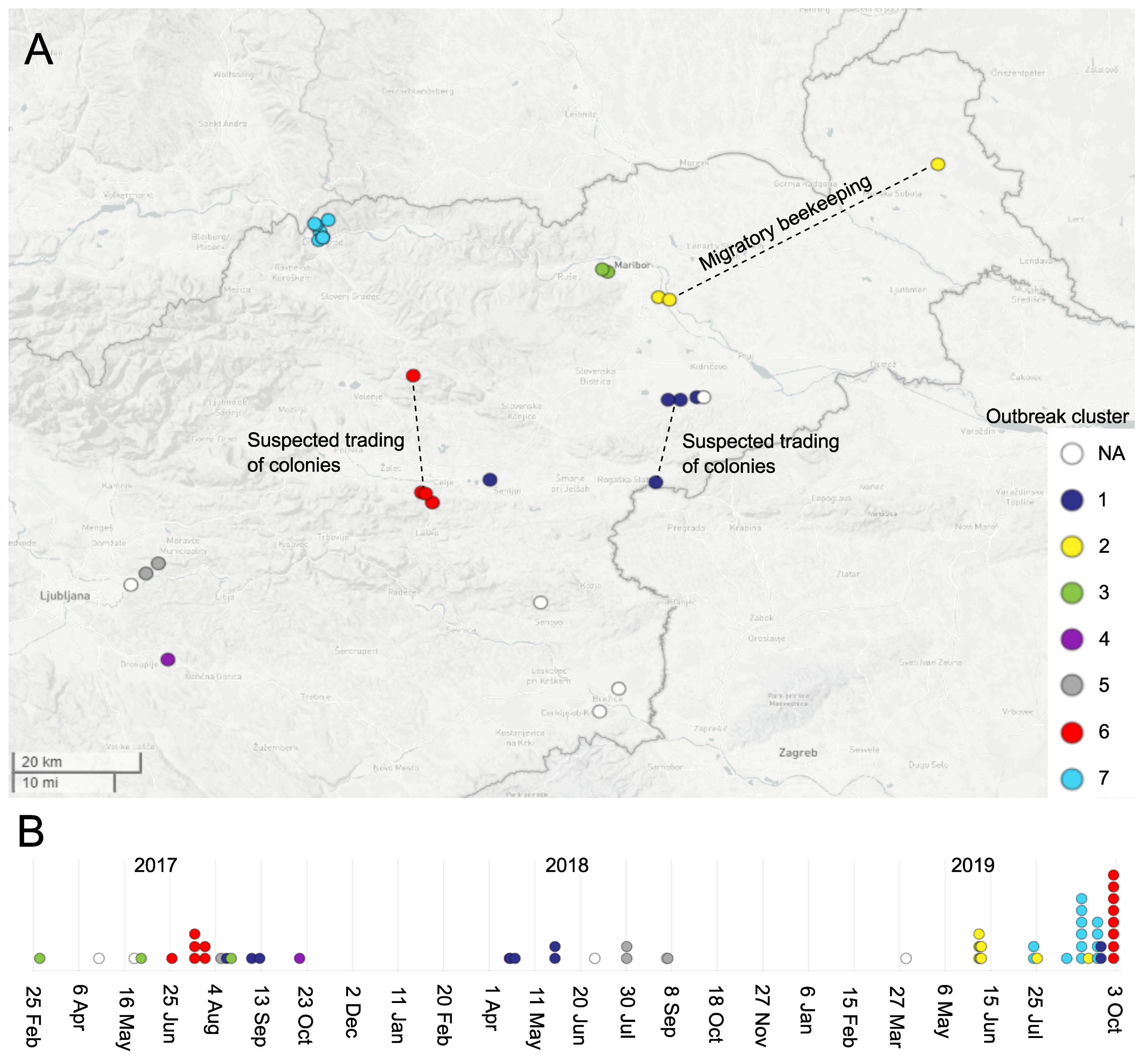ERIC and WGS Typing of Paenibacillus larvae in Slovenia: Investigation of ERIC I Outbreaks
Abstract
Simple Summary
Abstract
1. Introduction
2. Materials and Methods
2.1. Frequency and Spatiotemporal Distribution of ERIC Types
2.1.1. Isolate Selection
2.1.2. Isolate Cultivation and DNA Extraction
2.1.3. ERIC-PCR
2.1.4. Visualization of Spatiotemporal Data
2.2. Phylogeny and Clonal Relationship of Outbreak-Related ERIC I Isolates
2.2.1. Isolate Selection for WGS Typing
2.2.2. WGS Typing
2.2.3. In Silico 7-Gene MLST
3. Results
3.1. Frequency and Spatiotemporal Distribution of ERIC Types
3.2. Phylogeny and Clonal Relationship of Outbreak-Related ERIC I Isolates
3.3. P. larvae Transmission Routes
4. Discussion
4.1. Frequency and Spatiotemporal Distribution of ERIC Types
4.2. Phylogeny, Clonal Relationship and Transmission of Outbreak-Related ERIC I Isolates
5. Conclusions
Supplementary Materials
Author Contributions
Funding
Institutional Review Board Statement
Data Availability Statement
Acknowledgments
Conflicts of Interest
References
- Pravno-Informacijski Sistem Republike Slovenije. Pravilnik o Ukrepih za Ugotavljanje, Zatiranje, Obveščanje in Preprečevanje Hude Gnilobe čEbelje Zalege; Pravno-Informacijski Sistem Republike Slovenije: Ljubljana, Slovenia, 2020; p. 5. Available online: http://www.pisrs.si/Pis.web/pregledPredpisa?id=PRAV13788 (accessed on 19 March 2021). (In Slovenian)
- Food and Agriculture Organization of the United Nations. Good Beekeeping Practices: Practical Manual on How to Identify and Control the Main Diseases of the Honeybee (Apis mellifera): TECA—Technologies and Practices for Small Agricultural Producers; Food and Agriculture Organization of the United Nations: Rome, Italy, 2020; pp. 39–43. Available online: http://www.izslt.it/wp-content/uploads/2020/05/CA9182EN.pdf (accessed on 10 February 2021).
- Genersch, E.; Forsgren, E.; Pentikäinen, J.; Ashiralieva, A.; Rauch, S.; Kilwinski, J.; Fries, I. Reclassification of Paenibacillus larvae subsp. pulvifaciens and Paenibacillus larvae subsp. larvae as Paenibacillus larvae without subspecies differentiation. Int. J. Syst. Evol. Microbiol. 2006, 56, 501–511. [Google Scholar] [CrossRef] [PubMed]
- Beims, H.; Bunk, B.; Erler, S.; Mohre, K.I.; Spröer, C.; Silke, C.S.; Pradella, S.; Günther, G.; Rohde, M.; von der Ohe, W.; et al. Discovery of Paenibacillus larvae ERIC V: Phenotypic and genomic comparison to genotypes ERIC I-IV reveal different inventories of virulence factors which correlate with epidemiological prevalences of American Foulbrood. Int. J. Med. Microbiol. 2020, 310, e151394. [Google Scholar] [CrossRef] [PubMed]
- Genersch, E.; Ashiralieva, A.; Fries, I. Strain- and genotype-specific differences in virulence of Paenibacillus larvae subsp. larvae, a bacterial pathogen causing American foulbrood disease in Honeybees. Appl. Environ. Microbiol. 2005, 71, 7551–7555. [Google Scholar] [CrossRef] [PubMed]
- Rauch, S.; Ashiralieva, A.; Hedtke, K.; Genersch, E. Negative correlation between individual-insect-level virulence and col-ony-level virulence of Paenibacillus larvae, the etiological agent of American foulbrood of honey bees. Appl. Environ. Microbiol. 2009, 75, 3344–3347. [Google Scholar] [CrossRef] [PubMed]
- Morrissey, B.J.; Helgason, T.; Poppinga, L.; Fünfhaus, A.; Genersch, E.; Budge, G.E. Biogeography of Paenibacillus larvae, the causative agent of American foulbrood, using a new multilocus sequence typing scheme. Environ. Microbiol. 2014, 17, 1414–1424. [Google Scholar] [CrossRef] [PubMed]
- World Organization for Animal Health. Chapter 3.2.2.: American foulbrood of honey bees (infection of honey bees with Paenibacillus larvae). In OIE Terrestrial Manual, 8th ed.; World Organization for Animal Health: Paris, France, 2018; pp. 719–735. Available online: https://www.oie.int/fileadmin/Home/eng/Health_standards/tahm/3.02.02_AMERICAN_FOULBROOD.pdf (accessed on 10 March 2021).
- Papić, B.; Diricks, M.; Kušar, D. Analysis of the global population structure of Paenibacillus larvae and outbreak investigation of American foulbrood using a stable wgMLST scheme. Front. Vet. Sci. 2021, 8, 582677. [Google Scholar] [CrossRef] [PubMed]
- Loncaric, I.; Derakhshifar, I.; Oberlerchner, J.T.; Köglberger, H.; Moosbeckhofer, R. Genetic diversity among isolates of Pae-nibacillus larvae from Austria. J. Invertebr. Pathol. 2009, 100, 44–46. [Google Scholar] [CrossRef]
- Descamps, T.; De Smet, L.; Stragier, P.; De Vos, P.; De Graaf, D.C. Multiple locus variable number of tandem repeat analysis: A molecular genotyping tool for Paenibacillus larvae. Microb. Biotechnol. 2016, 9, 772–781. [Google Scholar] [CrossRef]
- Bassi, S.; Formato, G.; Milito, M.; Trevisiol, K.; Salogni, C.; Carra, E. Phenotypic characterization and ERIC-PCR based gen-otyping of Paenibacillus larvae isolates recovered from American foulbrood outbreaks in honey bees from Italy. Vet. Q. 2015, 35, 27–32. [Google Scholar] [CrossRef]
- Ueno, Y.; Yoshida, E.; Misumi, W.; Watando, E.; Suzuki, K.; Hirai, Y.; Okura, M.; Osaki, M.; Katsuda, K.; Takamatsu, D. Population structure and antimicrobial susceptibility of Paenibacillus larvae isolates from American foulbrood cases in Apis mellifera in Japan. Environ. Microbiol. Rep. 2018, 10, 210–216. [Google Scholar] [CrossRef]
- Ågren, J.; Schäfer, M.O.; Forsgren, E. Using whole genome sequencing to study American foulbrood epidemiology in honey-bees. PLoS ONE 2017, 12, e0187924. [Google Scholar] [CrossRef] [PubMed]
- Uelze, L.; Grützke, J.; Borowiak, M.; Hammerl, J.A.; Juraschek, K.; Deneke, C.; Tausch, S.H.; Malorny, B. Typing methods based on whole genome sequencing data. One Health Outlook 2020, 2, 1–19. [Google Scholar] [CrossRef] [PubMed]
- Bertolotti, A.C.; Forsgren, E.; Schäfer, M.O.; Sircoulomb, F.; Gaïani, N.; Ribière-Chabert, M.; Paris, L.; Lucas, P.; de Boisséson, C.; Skarin, J.; et al. Development and evaluation of a core genome multilocus sequence typing scheme for Paenibacillus larvae, the deadly American foulbrood pathogen of honeybees. Environ. Microbiol. 2021. [Google Scholar] [CrossRef]
- Genersch, E.; Otten, C. The use of repetitive element PCR fingerprinting (rep-PCR) for genetic subtyping of German field isolates of Paenibacillus larvae subsp. larvae. Apidologie 2003, 34, 195–206. [Google Scholar] [CrossRef][Green Version]
- Versalovic, J.; Schneider, M.; De Bruijn, F.J.; Lupski, J.R. Genomic fingerprinting of bacteria using repetitive sequence-based polymerase chain reaction. Methods Mol. Cell. Biol. 1994, 5, 25–40. [Google Scholar]
- Argimón, S.; Abudahab, K.; Goater, R.J.E.; Fedosejev, A.; Bhai, J.; Glasner, C.; Feil, E.J.; Holden, M.T.G.; Yeats, C.A.; Grund-mann, H.; et al. Microreact: Visualizing and sharing data for genomic epidemiology and phylogeography. Microb. Genomics 2016, 2, e000093. [Google Scholar] [CrossRef] [PubMed]
- Letunic, I.; Bork, P. Interactive Tree of Life (iTOL) v4: Recent updates and new developments. Nucleic Acids Res. 2019, 47, 256–259. [Google Scholar] [CrossRef]
- Jolley, K.A.; Bray, J.E.; Maiden, M.C.J. Open-access bacterial population genomics: BIGSdb software, the PubMLST.org website and their applications. Wellcome Open Res. 2018, 3, 124. [Google Scholar] [CrossRef]
- Genersch, E. American Foulbrood in honeybees and its causative agent, Paenibacillus larvae. J. Invertebr. Pathol. 2010, 103, 10–19. [Google Scholar] [CrossRef] [PubMed]
- Dingman, D.W. Comparative analysis of Paenibacillus larvae genotypes isolated in Connecticut. Arch. Microbiol. 2015, 197, 789–795. [Google Scholar] [CrossRef]
- Ebeling, J.; Knispel, H.; Fünfhaus, A.; Genersch, E. The biological role of the enigmatic C3larvinAB toxin of the honey bee pathogenic bacterium Paenibacillus larvae. Environ. Microbiol. 2019, 21, 3091–3106. [Google Scholar] [CrossRef] [PubMed]
- Rusenova, N.; Parvanov, P.; Stanilova, S. Molecular typing of Paenibacillus larvae strains isolated from Bulgarian apiaries based on repetitive element polymerase chain reaction (Rep-PCR). Curr. Microbiol. 2013, 66, 573–577. [Google Scholar] [CrossRef] [PubMed]
- Chen, Y.; Luo, Y.; Carleton, H.; Timme, R.; Melka, D.; Muruvanda, T.; Wang, C.; Kastanis, G.; Katz, L.S.; Turner, L.; et al. Whole genome and core genome multilocus sequence typing and single nucleotide polymorphism analyses of Listeria monocytogenes isolates associated with an outbreak linked to cheese, United States, 2013. Appl. Environ. Microbiol. 2017, 83, e00633–e00717. [Google Scholar] [CrossRef]
- Pightling, A.W.; Pettengill, J.B.; Luo, Y.; Baugher, J.D.; Rand, H.; Strain, E. Interpreting whole-genome sequence analyses of foodborne bacteria for regulatory applications and outbreak investigations. Front. Microbiol. 2018, 9, 1482. [Google Scholar] [CrossRef] [PubMed]




| Year | ERIC I (%) | ERIC II (%) | Total No. of Isolates |
|---|---|---|---|
| 2017 | 44.2 | 55.8 | 86 |
| 2018 | 14.5 | 85.5 | 83 |
| 2019 | 26.5 | 73.5 | 102 |
Publisher’s Note: MDPI stays neutral with regard to jurisdictional claims in published maps and institutional affiliations. |
© 2021 by the authors. Licensee MDPI, Basel, Switzerland. This article is an open access article distributed under the terms and conditions of the Creative Commons Attribution (CC BY) license (https://creativecommons.org/licenses/by/4.0/).
Share and Cite
Žugelj, A.; Papić, B.; Zdovc, I.; Zajc, U.; Golob, M.; Avberšek, J.; Kušar, D. ERIC and WGS Typing of Paenibacillus larvae in Slovenia: Investigation of ERIC I Outbreaks. Insects 2021, 12, 362. https://doi.org/10.3390/insects12040362
Žugelj A, Papić B, Zdovc I, Zajc U, Golob M, Avberšek J, Kušar D. ERIC and WGS Typing of Paenibacillus larvae in Slovenia: Investigation of ERIC I Outbreaks. Insects. 2021; 12(4):362. https://doi.org/10.3390/insects12040362
Chicago/Turabian StyleŽugelj, Alenka, Bojan Papić, Irena Zdovc, Urška Zajc, Majda Golob, Jana Avberšek, and Darja Kušar. 2021. "ERIC and WGS Typing of Paenibacillus larvae in Slovenia: Investigation of ERIC I Outbreaks" Insects 12, no. 4: 362. https://doi.org/10.3390/insects12040362
APA StyleŽugelj, A., Papić, B., Zdovc, I., Zajc, U., Golob, M., Avberšek, J., & Kušar, D. (2021). ERIC and WGS Typing of Paenibacillus larvae in Slovenia: Investigation of ERIC I Outbreaks. Insects, 12(4), 362. https://doi.org/10.3390/insects12040362






